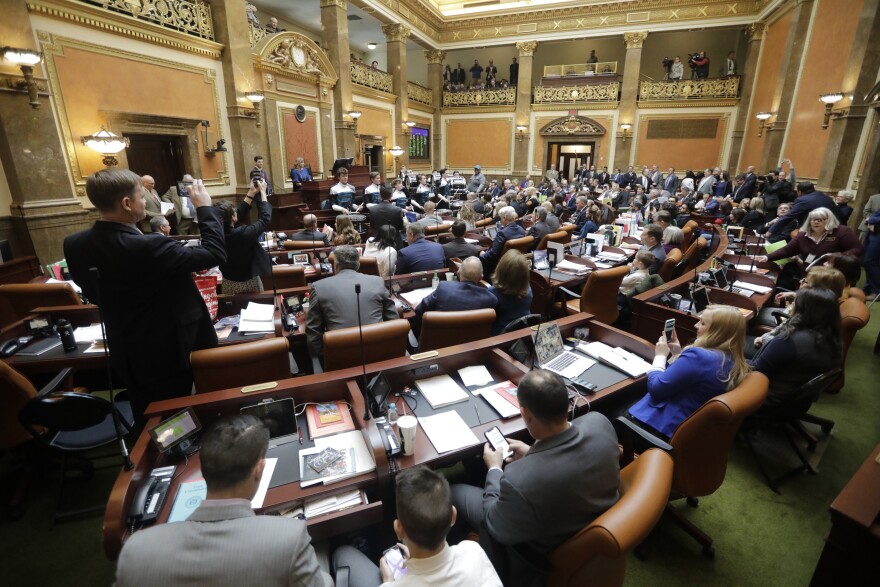Last Thursday, during a debate on the Utah Senate floor, Sen. Ron Winterton, R-Roosevelt, rose to speak about a 4,000-line bill promoting affordable housing. He asked the floor sponsor, Sen. Jacob Anderegg, R-Lehi, to change one word.
“I represent Summit County and they wanted to know if the sponsor would change a ‘shall’ to a ‘may,’” Winterton said. “Because it seems like it's forcing a hand to the county up there and doesn't give them an option.”
Anderegg refused Winterton’s request, and the bill, HB 462, passed. It is now on its way to the governor's office and is expected to be signed into law.
Summit County Deputy County Manager Janna Young said the “shall” in question — which appears in line 3,581 — only applies to Summit County. It essentially requires the county to allow density of at least 39 units per acre in a portion of Kimball Junction.
“What we do know, at this point, fairly definitively, is that (HB) 462 does require the county to create a housing and transit reinvestment zone,” Young said. "We know that that zone has to be within 1/3 of a mile of the transit hub there in Kimball Junction. And we do know that by virtue of creating it, we have to allow density within that zone of 39-49 units per acre."
A housing and transit reinvestment zone, or HTRZ, is a financing tool the Legislature created last year and altered during this year's general session. The latest legislation requires at least 51% of the developable land inside an HTRZ to average at least 39 units per acre. That's down from 50 units per acre, a change Summit County says was made at its behest.
Developer Dakota Pacific Real Estate included 58 acres as the project site for its now-withdrawn proposal to build 1,100 homes at Kimball Junction. If the HTRZ density was applied to Dakota Pacific’s land, it would yield at least 1,154 units.
There has been no official public discussion about how much land would be included in an HTRZ at Kimball Junction or if the HTRZ would include any of Dakota Pacific’s holdings.
A Dakota Pacific representative declined a request for comment, referencing instead a statement the firm released last week as the bills were being debated. In that statement, CEO Marc Stanworth declined to say whether Dakota Pacific had lobbied the legislature for the HTRZ language. He said the firm was pleased to see legislators addressing what he called Utah’s severe housing shortage.
As recently as December, Summit County officials touted the HTRZ as a way to help pay for projects like the county’s long-sought bus rapid transit system or costly fixes to Kimball Junction roads. The HTRZ was described as a potential benefit of approving Dakota Pacific’s proposal.
But County Manager Tom Fisher said officials are seeing the HTRZ in a new light after the Legislature's recent actions.
“When legislation is telling local elected officials that you have to do it, or there's a hammer that comes from that from a legislative tool, that changes the conversation,” he said.
Young said the county is exploring potential ways to get around the requirement, but whether to actually do so would be a decision for the county council. In the meantime, there remains plenty to negotiate about the Kimball Junction HTRZ, including how big it will be and what land it will contain.
And while an HTRZ requires specific density, Young said the legislation doesn’t determine how those housing units would be built.
“It doesn't require us to approve anything,” Young said. “I think, by virtue of having to set up this HTRZ, it essentially creates the zoning that Dakota Pacific wanted in that area of the county. But, you know, the development agreement still has to be approved. We're still waiting for them to come back with a plan C, which we don't know what that looks like yet.”
Dakota Pacific withdrew the 1,100-home proposal late last year after overwhelming community opposition. It is expected to bring forward another plan in coming months.
This is not the first time Summit County has alleged the Legislature has specifically targeted its land-use decisions. In July 2020, Hideout used changes in state code made in March and repealed in August to annex land in Summit County.
Litigation about that annexation is ongoing.


